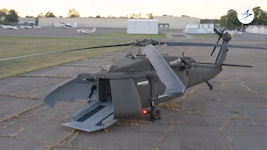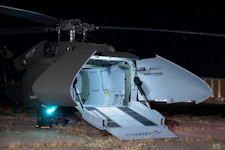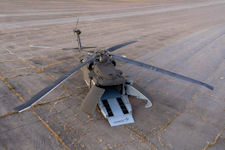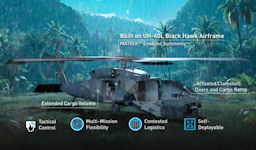Sikorsky S-70UAS U-Hawk™
Sikorsky successfully converted the UH-60L Black Hawk helicopter into a fully autonomous unmanned aircraft called the S-70UAS U-Hawk. The transformation took just ten months from initial concept to working prototype, representing a major shift in military logistics and cargo transport capabilities.
The most dramatic change is the complete removal of the cockpit. Where pilots once sat, the U-Hawk now has actuated clamshell doors and an integrated loading ramp. This redesign creates 25% more cargo space than a standard Black Hawk while keeping the aircraft's proven reliability and performance. The platform uses third-generation fly-by-wire systems combined with Sikorsky's MATRIX autonomy technology, allowing it to fly without onboard pilots.
The U-Hawk offers impressive operational capabilities. It can fly 1,600 nautical miles without refueling or loiter for approximately 14 hours on station. The aircraft maintains its external cargo hook capability, lifting 9,000 pounds for sling-load operations. Inside, the expanded cargo bay can hold up to four Joint Modular Intermodal Containers (JMIC), double the capacity of a conventional Black Hawk.
The conversion process involved comprehensive structural changes. Sikorsky Innovations removed the entire cockpit section including all forward bulkheads, windscreens, pilot stations, crew seats, and associated instrumentation. This freed up substantial interior volume and yielded the 25% increase in usable cargo space.
The custom-designed clamshell doors open laterally to provide unprecedented forward access to the cargo bay. A hydraulically-operated loading ramp integrates with these doors, creating a wide opening that fundamentally changes how the aircraft can be loaded. Unlike conventional helicopters that rely on side doors, the U-Hawk enables drive-on/drive-off operations and straight-through loading.
The aircraft incorporates a state-of-the-art fly-by-wire system that completely replaces the conventional mechanical and hydraulic flight controls of the original Black Hawk. This advanced architecture offers reduced weight, enhanced reliability, improved maintenance accessibility, and seamless integration with autonomous flight systems.
At the heart of the U-Hawk sits Sikorsky's MATRIX autonomy technology. This sophisticated system uses advanced sensors, multiple redundant cameras, precision GPS, inertial navigation systems, and artificial intelligence algorithms to enable fully autonomous flight operations. MATRIX handles everything from pre-flight checks and takeoff through navigation, obstacle avoidance, mission execution, and landing without human intervention in the cockpit.
Development Timeline
The rapid ten-month development demonstrates exceptional capabilities in accelerated aerospace development. The first two months focused on comprehensive design studies and engineering feasibility assessments. Months three and four involved detailed computer-aided design modeling and structural simulations. Component procurement occurred in months five and six. Physical fabrication of custom modifications took place in months seven and eight. System integration happened in month nine, followed by comprehensive ground testing in month ten. First flight is scheduled for 2026.
Mission Capabilities
The U-Hawk's versatile design supports an impressive array of mission types. One of the most innovative capabilities is transporting unmanned ground vehicles. The HDT Hunter Wolf 6x6 UGV can drive directly onto the U-Hawk's loading ramp and into the cargo bay. Upon arrival at the destination, the doors open, the ramp deploys, and the vehicle drives off autonomously to begin its ground mission. This creates unprecedented air-ground team capabilities for deploying robotic systems into contested environments without exposing human operators to danger.
For containerized cargo operations, the expanded cargo bay enables transport of up to four JMICs, doubling logistical efficiency compared to conventional Black Hawks. A single U-Hawk sortie can accomplish what previously required two flights.
The aircraft can accommodate a complete HIMARS rocket pod containing six precision-guided rockets, or two Naval Strike Missiles with ranges exceeding 100 nautical miles. This creates new tactical possibilities such as rapid repositioning of precision fires or delivery of reload pods to forward positions.
The cargo bay can be equipped with specially designed "quivers" that hold multiple small drones vertically or horizontally. These launched effects can be configured for reconnaissance swarms, strike swarms, or communication relay networks, transforming the U-Hawk into a force multiplier capable of projecting distributed effects across wide areas.
Additional internal fuel tanks enable the extended range and endurance operations, allowing self-deployment over 1,600 nautical miles or approximately 14 hours of loiter time. This enables strategic mobility across entire theaters of operation and persistent presence for extended surveillance or logistics support missions.
Operator-Centric Control
One of the U-Hawk's most revolutionary aspects is the fundamental reconceptualization of aircraft control. Traditional helicopters require highly trained pilots with years of expensive flight training. The U-Hawk eliminates this requirement entirely. Instead of aviators, the U-Hawk is flown by operators who may have no traditional flight training whatsoever. These operators function as mission managers, defining objectives and allowing the aircraft's autonomy systems to handle all aspects of flight.
The entire control system is accessible through a ruggedized tablet computer that provides an intuitive touchscreen interface. This tablet gives the operator complete command authority over the U-Hawk from initial startup through mission execution to final shutdown. The interface presents complex flight operations in straightforward, task-oriented terms.
The advantages of tablet-based control include minimal training requirements, reduced personnel costs compared to maintaining rated pilots, flexibility in operator assignments, enhanced operational security with no valuable pilots at risk, and simplified logistics since tablets are easily transportable and replaceable.
Loading and Mission Execution
The loading process exemplifies the design philosophy of simplicity and efficiency. When the operator activates the loading sequence via tablet, the clamshell doors automatically unlock and open outward in coordinated motion. Simultaneously, the integrated loading ramp hydraulically extends and lowers to ground level, creating a stable access path into the cargo bay. This entire process takes only seconds.
With the aircraft open and ready, cargo can be loaded through multiple methods. Vehicles drive directly up the ramp, forklifts position heavy loads, palletized cargo rolls into position, ground crews manually load smaller items through forward or side openings, or external cargo attaches to the cargo hook.
Once loading is complete, the operator initiates the securing and closing sequence through the tablet. The automated system verifies proper cargo security using weight and balance sensors, then reverses the opening sequence. The ramp retracts and raises, clamshell doors close and lock, and the aircraft performs automated pre-flight checks.
For mission planning, operators use a goal-oriented approach rather than plotting specific routes or calculating fuel requirements. The operator simply inputs mission parameters through the tablet interface including destination coordinates, desired arrival time, mission priority level, and specific constraints such as altitude restrictions or areas to avoid.
The MATRIX autonomy system processes operator inputs and automatically generates a complete flight plan that optimizes for mission success while maintaining safety margins. The system considers current and forecast weather conditions, known or suspected threat locations, terrain features and obstacles, fuel requirements and aircraft performance limits, air traffic control requirements and airspace restrictions, and multiple alternative routes in case of unexpected obstacles or threats.
During flight, MATRIX continuously monitors conditions through its integrated sensor suite. Forward-looking and omnidirectional cameras provide visual awareness. Radar systems detect other aircraft and obstacles. GPS and inertial navigation systems precisely track position and velocity. Weather sensors monitor conditions ahead, and communication systems receive updated intelligence and routing information.
If the system detects obstacles, weather hazards, or other threats along the planned route, it automatically calculates alternative paths and adjusts course without operator intervention. The operator receives notifications of significant route changes but doesn't need to approve these adjustments.
Strategic Advantages
According to Rich Benton, Sikorsky Vice President and General Manager, "Sikorsky is innovating a 21st-century solution by converting UH-60L Black Hawks into a fully autonomous utility platform. We developed this prototype from concept to reality in under a year, and the modifications made to transform this crewed Black Hawk into a multi-mission payload UAS can be replicated at scale quickly and affordably. The U-Hawk continues the Black Hawk legacy of being the world's premier utility aircraft and opens the door to new capabilities as a UAS."
The U-Hawk concept offers compelling economic and operational advantages. The U.S. military and allied nations operate hundreds of UH-60L Black Hawks, older variants gradually being replaced by more modern UH-60M models. Rather than retiring these still-capable airframes, the U-Hawk conversion program offers a path to extract continued value. Each converted U-Hawk represents extended useful life for an existing asset, avoided costs of new-build aircraft procurement, retention of a proven airframe with established maintenance procedures, and opportunity to offload dangerous or routine missions from crewed aircraft.
Because the U-Hawk retains the fundamental UH-60 airframe structure, engines, transmission, and rotor systems, it shares extensive commonality with the existing Black Hawk fleet. Maintenance technicians require minimal additional training. Spare parts inventories largely overlap with existing Black Hawk stocks. Maintenance facilities and support equipment remain applicable. Supply chains and logistics systems require minimal modification. Reliability and performance characteristics are well-understood from decades of operations.
The uncrewed nature creates multiple cost-saving opportunities. Converting an existing UH-60L airframe is significantly less expensive than procuring a new aircraft. Autonomous operation eliminates several major cost categories including pilot salaries, flight training costs which can exceed $1 million per pilot over a career, crew life support systems maintenance, and crew scheduling overhead. Removal of cockpit systems, crew stations, and redundant pilot interfaces eliminates numerous components requiring periodic inspection, maintenance, and replacement.
Igor Cherepinsky, Sikorsky Innovations Director, explained: "The U-Hawk offers a cost-effective utility UAS by leveraging commonality with the existing UH-60 fleet, and its uncrewed nature reduces both operating and maintenance costs. We focused on efficiencies in the retrofit by designing and manufacturing vehicle management computers, actuation components, and airframe modifications. We will incorporate those efficiencies into future modifications and manufacturing for our family of UAS products."
Production Scalability
The ten-month development timeline provides a foundation for rapid production scaling. Sikorsky Innovations deliberately focused on manufacturing efficiency during the design phase, creating modification processes that can be replicated quickly and consistently. Conversion facilities can be established relatively quickly. Multiple aircraft can be processed simultaneously. Learning curve benefits will reduce per-unit costs and timelines as production volumes increase. Standardized modification kits can be pre-manufactured and stocked for rapid installation.
Cherepinsky's reference to "our family of UAS products" hints at broader ambitions. The technologies, processes, and lessons learned could be applied to other variants of Black Hawk helicopters, different mission-specific configurations of the U-Hawk itself, entirely new unmanned rotorcraft designs, and autonomy packages that could be retrofitted to various existing aircraft types.
Technical Implementation
The fly-by-wire system represents a significant technological advancement, specifically designed as a low-cost solution that maintains high reliability standards. Unlike mechanical flight controls where pilot inputs are transmitted through cables and hydraulics directly to flight control surfaces, the U-Hawk's system uses electronic sensors to detect control inputs from the MATRIX autonomy system, processes these inputs through redundant flight control computers, and transmits electronic signals to hydraulic actuators that move the control surfaces.
The cost optimization reflects several design choices including use of commercial-off-the-shelf components where appropriate, simplified redundancy architecture, integration of control functions into fewer capable computing units, modern manufacturing techniques, and software-based rather than hardware-based system configurations.
MATRIX integrates data from multiple sensor types to build comprehensive environmental understanding. Visual cameras provide situational awareness and obstacle detection. Infrared cameras enable operations in low-light or night conditions. Radar systems detect other aircraft and map terrain. LIDAR creates precise three-dimensional maps of surroundings. GPS provides global position information. Inertial measurement units track acceleration and rotation. Barometric sensors measure altitude. Airspeed sensors monitor velocity through the air.
The system continuously processes sensor data, comparing inputs from multiple sources to detect sensor failures or anomalies and maintaining accurate situational awareness even if individual sensors fail.
MATRIX employs sophisticated AI algorithms that recognize and classify objects in the environment, predict the behavior of dynamic objects, learn from experience to improve performance over time, and adapt to unexpected situations using reasoning capabilities rather than just following pre-programmed responses.
The autonomy system makes tactical decisions across multiple time scales. At the millisecond level, it makes immediate flight control adjustments to maintain stable flight. At the second level, it executes collision avoidance maneuvers and turbulence compensation. At the minute level, it adjusts routes around weather or obstacles. At the hour level, it manages fuel and optimizes mission timelines.
Multiple layers of safety systems ensure reliable operation including redundant flight control computers with diverse processors, continuous self-diagnostics that detect system anomalies, safe mode behaviors that activate if critical failures are detected, geofencing capabilities that prevent flight into restricted areas, and programmable flight envelope protections that prevent dangerous maneuvers.
Operational Implications
The U-Hawk's capabilities open numerous operational possibilities for military forces. Traditional logistics helicopters require exposing valuable pilots and crew to hostile fire. The U-Hawk enables sustained logistics operations in areas where air defenses make crewed operations unacceptably risky. If a U-Hawk is shot down, the loss is measured only in hardware costs, not in trained personnel.
Modern military doctrine emphasizes distribution of forces across wide areas to complicate enemy targeting. The U-Hawk's autonomous operation and extended range enable support of these distributed forces without requiring co-location of aircraft, crews, and maintenance facilities. A single operations center could control multiple U-Hawks supporting units across hundreds of miles.
The ability to rapidly deploy cargo to disaster zones without risking crew in potentially hazardous conditions makes the U-Hawk valuable for emergency response. Multiple U-Hawks could autonomously shuttle supplies from distribution centers to numerous disaster-affected communities simultaneously.
The ability to deliver equipment or supplies to remote locations with precision, then depart without landing using hover and cargo hook operations, enables covert logistics support to special operations teams without exposing crewed aircraft or requiring personnel to remain in hostile areas.
Challenges and Considerations
Despite its impressive capabilities, the U-Hawk faces several challenges. Operating large autonomous aircraft in civil airspace raises significant regulatory questions. Aviation authorities worldwide will need to develop new regulations, certification standards, and operational procedures for unmanned aircraft of this size and capability. The process of gaining civilian airworthiness certification could be lengthy and complex.
Regulators must determine appropriate safety standards for autonomous aircraft. While removing pilots eliminates crew risk, the aircraft still poses risks to people on the ground and to other aircraft. Demonstrating that MATRIX autonomy provides safety levels equivalent to or better than human pilots will be critical.
Legal frameworks for liability in the event of accidents involving autonomous aircraft remain underdeveloped. Questions about responsibility among manufacturers, operators, software developers, and sensor providers must be resolved to enable widespread adoption.
While the MATRIX system can handle many challenging conditions, extreme weather such as severe icing, thunderstorms, or severe turbulence might exceed autonomous system capabilities. Determining appropriate weather limitations and ensuring operators understand these limitations will be important for safe operations.
Although MATRIX enables autonomous operation, operators still need to communicate with the aircraft to provide mission updates, receive status information, and intervene if necessary. Operations in areas with limited or denied communications could be challenging.
Autonomous systems are potentially vulnerable to cyber attacks including jamming, spoofing, or hacking attempts that could disrupt operations or even allow hostile actors to take control. Robust cybersecurity measures must be integrated into all aspects of the system.
Public comfort with large autonomous aircraft operating overhead will need to develop over time. High-profile failures of autonomous systems in other domains might create skepticism that must be overcome through demonstrated safety records.
The replacement of pilots with operators might face resistance from aviation professional organizations concerned about job losses. While operators still have an important role, the elimination of traditional piloting positions could create workforce disruption.
Looking Forward
The Sikorsky S-70UAS U-Hawk represents a watershed moment in aviation technology. The successful transformation of one of the world's most proven helicopter platforms into a fully autonomous, mission-flexible unmanned aircraft system is particularly impressive given the compressed development timeline and the thoughtful attention to operational practicality, economic viability, and production scalability.
By building on the proven Black Hawk foundation, Sikorsky has created a platform that offers immediate utility while pointing toward a future of increasingly capable autonomous aircraft. The 25% increase in cargo capacity, combined with the innovative forward-loading configuration and the sophisticated MATRIX autonomy system, creates operational possibilities that simply didn't exist before.
The U-Hawk's appearance at the October 2025 AUSA exposition marks the beginning of what is likely to be a long developmental journey. First flight in 2026 will validate the fundamental concept and provide critical data for refining the autonomy systems. Subsequent testing will expand the flight envelope, explore the various mission configurations, and demonstrate the reliability necessary for operational deployment.
The technologies and approaches pioneered in this program will likely influence a generation of autonomous aircraft across both military and civilian applications. The lessons learned in converting crewed aircraft to autonomous operation, the manufacturing efficiencies developed for economical conversion, and the operational concepts validated through real-world employment will all contribute to an aviation future in which autonomous and crewed aircraft operate side-by-side.
The U-Hawk doesn't replace the traditional Black Hawk, it complements it. Crewed Black Hawks will continue to excel in missions requiring human judgment, real-time decision-making in complex environments, and tasks that benefit from onboard crew. The U-Hawk will handle missions where autonomous operation offers advantages including dangerous environments, long-duration operations, routine logistics runs, and missions where the cargo itself is more valuable than the aircraft carrying it.
Since its introduction in 1979, the Black Hawk has proven itself in countless conflicts, disasters, and humanitarian operations worldwide. The U-Hawk takes this legacy forward, adapting one of aviation's most successful platforms for the operational challenges of the 21st century. With first flight approaching in 2026, the aviation world watches with interest as this innovative platform moves from concept to operational reality.
|
NEWSLETTER
|
| Join the GlobalSecurity.org mailing list |
|
|
|





